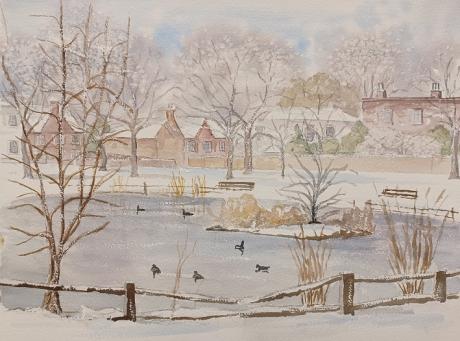" P Yates" and inscribed on the reverse
For hundreds of years Ham Pond played a vital if unromantic part in village life as a drinking place for the sheep and cattle on the common. Today the pond has new roles as a place for calm public enjoyment, a wildlife haven, and as a key reminder of our village heritage. The Pond is cared for by the Ham Pond Group, supported by the Ham and Petersham Association, and working in collaboration with Richmond Council. In accordance with its objectives, the Association has actively supported the Ham Pond Group ever since it was formed to look after the pond in 2000.
Ham Common is an area of common land in Ham, London. It is a conservation area in, and managed by, the London Borough of Richmond upon Thames. It comprises 48.69 hectares (120.3 acres), the second largest area of common land in the borough, 2 acres (0.81 ha) smaller than Barnes Common. It is divided into two distinct habitats, grassland and woodland, separated by the A307, Upper Ham Road. It is an area of ecological, historical and recreational interest, designated a Local Nature Reserve.
To the west of the Upper Ham Road lies a triangular green of approximately 20 acres (8.1 ha), bounded by mature trees and crossed by an avenue that forms part of the southern approach to Ham House. There is a village pond near the western corner which attracts water fowl and other wildlife in the western section.
On the eastern side of Upper Ham Road (A307) lies a larger wooded area, Ham Common Woods, that extends for 1 kilometre (0.62 mi) to Richmond Park in the east and Sudbrook Park, Petersham to the north. The B352 road, Ham Gate Avenue, crosses this area, linking the A307 to Richmond Park at Ham Gate. The Latchmere Stream, now culverted for most of its course, has its outfall in a pond near Ham Gate in Ham Common Woods. Two cedar trees were planted to mark King George V's coronation in 1911.
Since the cessation of grazing in the 1930s, the eastern section has transitioned from acid grassland heath with gorse, bracken and bramble, to mixed oak woodland. Pioneer birch, now dying back, is giving way to holly, yew and oak. The thick under-storey of this habitat contrasts with the open, deer-grazed woodland in adjacent Richmond Park to the east and the mown grasslands of the western section and Richmond Golf Club in Sudbrook Park to the north. The local authority and volunteer groups manage the habitat, keeping paths and bridleways clear and removing invasive species such as Snowberry. The remaining open area of sandy, acid grassland has a noted colony of the Ashy mining bee and other solitary bees.
Parts of Church Road, Ham Common are closed to traffic in spring to protect migrating toads to cross safely. New ponds were constructed in early 2017 by Froglife and Richmond Council to provide a habitat for the Common Toad.

